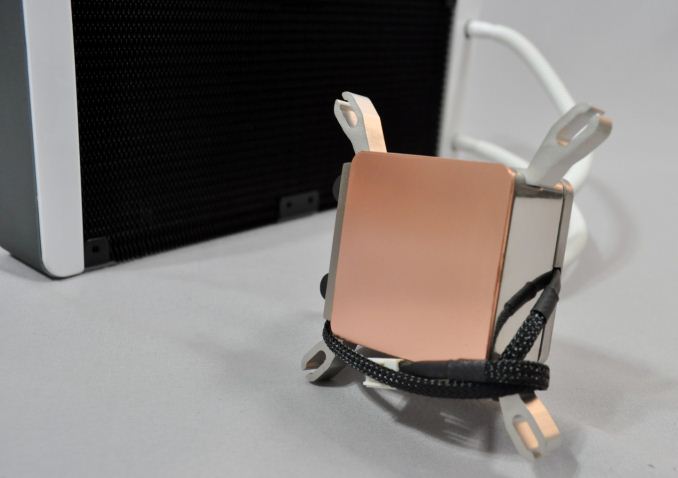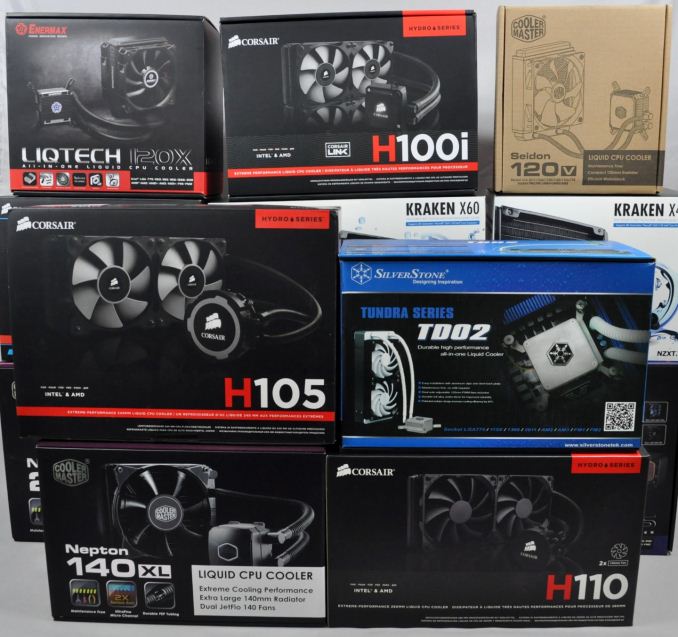Closed Loop AIO Liquid Coolers: 14-way Mega Roundup Review
by E. Fylladitakis on February 12, 2014 7:00 AM EST
Remember the time when liquid cooling a computer chip was considered to be an extreme approach, one performed by hardcore enthusiasts and overclockers alone? Everything had to be personally designed and or procured by the user, as there were no specialized commercial products available at the time. Radiators were modified heater cores extracted from cars, CPU blocks were rare and occasionally machined at local workshops using a copper block and a lathe, while high-performance tubing came from shops with medical supplies.
As demand grew, aided by the ever-increasing noise of small CPU heatsinks, companies specializing on liquid cooling solutions began turning up -- a little too fast perhaps, as tens of companies were founded within a few months' time and very few of them actually survived for more than a couple of years. Enthusiasts could then buy specialized liquid cooling equipment and even whole kits from just one seller and only had to assemble the setup into their system. That of course is no simple process for an amateur and a nightmare for a system builder, who cannot ship a system with a topped off water cooling tank or assume that the user has the skills required to maintain such a system, therefore the potential market remained limited to advanced users only.
This all changed in 2012, when Asetek came up with an inexpensive closed loop solution, a liquid cooling device that was leak-free and required no maintenance at all. The radiators of the first few solutions were small and their overall performance hardly better than that of air coolers; however, aided by the modernization of computer cases, the mounting of larger, thicker radiators inside a PC soon was not a problem. In many cases the kits were now no harder to install than any CPU cooler and required no maintenance at all, opening the market to virtually every computer user seeking a performance cooling solution. This spurred massive interest amongst OEMs and manufacturers, who all strive for a slice of the pie.
There have been tens of AIO (All-in-One) closed loop liquid coolers released just in 2013; today, we are having a roundup with 14 of them, coming from five different manufacturers, alphabetically listed in the table below.
| Product | Radiator Effective Surface | Radiator Thickness | # of Fans (Supplied / Maximum) | Speed Range of Supplied Fans (RPM) | Current Retail Pricing |
| Cooler Master Seidon 120V | 120mm × 120mm | 27mm | 1 / 2 | 600-2400 | $49.99 |
| Cooler Master Nepton 140XL | 140mm × 140mm | 38mm | 2 / 2 | 800-2000 | $99.99 |
| Cooler Master Nepton 280L | 140mm × 280mm | 30mm | 2 / 4 | 800-2000 | $119.99 |
| Corsair H75 | 120mm × 120mm | 25mm | 2 / 2 | 800-2000 | $69.99 |
| Corsair H90 | 140mm × 140mm | 27mm | 1 / 2 | 600-1500 | $84.99 |
| Corsair H100i | 120mm × 240mm | 27mm | 2 / 4 | 800-2700 | $109.99 |
| Corsair H105 | 120mm × 240mm | 38mm | 2 / 4 | 800- 2700 | $119.99 |
| Corsair H110 | 140mm × 280mm | 29mm | 2 / 4 | 600-1500 | $126.99 |
| Enermax Liqmax 120S | 120mm × 120mm | 32mm | 1 / 2 |
600-1300 600-2000 600-2500 (Multi-range) |
$163.00* |
| Enermax Liqtech 120X | 120mm × 120mm | 43mm | 2 / 2 |
600-1300 600-2000 600-2500 (Multi-range) |
$171.10* |
| NZXT Kraken X40 | 140mm × 140mm | 27mm | 1 / 2 | 800-2000 | $89.99 |
| NZXT Kraken X60 | 140mm × 280mm | 27mm | 2 / 4 | 800-2000 | $119.99 |
| Silverstone Tundra TD02 | 120mm × 240mm | 45mm | 2 / 4 | 1500-2500 | $118.99 |
| Silverstone Tundra TD03 | 120mm × 120mm | 45mm | 2 / 2 | 1500-2500 | $97.99 |
*The coolers from Enermax are not widely available in the USA at the time of this review, with the only viable option appearing to be that of import from Asia or Europe.
Although Asetek was the first to come up with the design and they hold patents for it, they are not the only OEM of AIO cooling solutions today. At least three different OEMs are behind the kits listed in the table above. We will have a closer look at each one of them in the following pages.











139 Comments
View All Comments
Dustin Sklavos - Wednesday, February 12, 2014 - link
Good lord.If I'd known my successor would produce results this thorough I'd've stepped aside a long time ago.
Really well done piece of work.
E.Fyll - Wednesday, February 12, 2014 - link
Thank you for the praise Dustin, yet I still stand unworthy of it. :)Dustin Sklavos - Wednesday, February 12, 2014 - link
I'm enjoying your work tremendously. Now that I'm at Corsair I'm glad we have someone we can send case/cooling/PSU hardware to that meets and beats the AnandTech standard.creed3020 - Wednesday, February 12, 2014 - link
Yeah Dustin....I have seriously enjoyed your labors here at AT and do miss them. Your successor has changed the paradigm so much that it's hard to compare, but it's a awesome reboot to this area of reviews here at AT.I, however, have to agree with many other commenters that a secondary dataset produced with the same 120mm/140mm fans does have it's merit as it will provide an objective evaluation of the radiator and pumps. This is one area where I am really curious to see quality differences in the products. I am fully aware that each OEM is very careful in their selection of a fan which matches their product. This is not done by lottery, that much is clear to me. The OEM behind the Silverstone/Enermax product intrigues me, as I am a fan of Silverstone products and use their cases exclusively for all of my desktops, gaming PCs, and HTPCs. The Tundra's seems like they are ripe for a revision!
BigLeagueJammer - Wednesday, February 12, 2014 - link
Under Noise Level Reference Values, your first one of <35dB(A) being "Virtually inaudible" doesn't match up with most sources I've seen. Most rate that as "very quiet" and say the limit of human hearing as 10 db(A). If other sources say things like a ticking watch is around 20 db(A) which in a quiet room is easy to hear, then 35 seems too high for your qualification of "virtually inaudible".E.Fyll - Wednesday, February 12, 2014 - link
True, I am afraid that the lot of "copy/paste-ing" online has produced a lot of bad information going around. Some are works of fiction, some are misinterpretations of confused people, some...I don't even want to know.So, copying my answer from above:
"Sub-35 dB(A) levels are generally impossible to notice by a human ear. Sub-30 dB(A) levels are next to impossible to record with anything less than science lab-grade equipment. There is no handheld or desktop dB(A) meter that can perform such readings. If you have seen reviews stating sub-30 dB(A) levels, make sure to check their methodology (given that there is any). Either the meter cannot read lower than 30 dB(A) (and/or will display a bogus reading, as most cheap Chinese meters do) and the review is a fictional text or their methodology is based on dB readings, not dB(A) readings, which is useless to a consumer."
I think it will suffice for me to say that you cannot possibly hear what an instrument designed for this specific purpose cannot even record. In theory, the human hearing threshold is 1 dB(A); in practice however, that is true only for specific frequencies. The background noise of a typical room is almost always above 32-33dB(A).
Jon-R - Wednesday, February 12, 2014 - link
What is your opinion on the tests done over at SilentPCReview? They test using lab-grade equipment. A rundown can be found here: http://www.silentpcreview.com/article875-page2.htm...They use reference fans which measure around 13dBA at their slowest fan speeds, and they don't think highly of AIO water-cooling at all, as none of the tested ones have come close to the best air-coolers when it comes to quiet cooling.
E.Fyll - Wednesday, February 12, 2014 - link
From what I can see, they are using a highly sensitive microphone and a computer's sound card to record the results, connected through an amplifier. Although the equipment is very good, this is not "lab grade equipment" but just a customized setup. A very good setup nonetheless, including an anechoic chamber. They have a microphone with a self-noise of 8 dB, which measures 11 dB(A) inside the aforementioned anechoic chamber.It will suffice to say that their results are just in no way comparable to mine. Actually, as noise level measurements are environment-specific, you should only compare the results of a same setup, never in-between different setups. Unless they are all science labs with multiple ISO certifications, of course. Given that my room floor noise level is over 30 dB(A) and they are using a sub-12 dB(A) anechoic chamber, I believe that I do not have to stress how different the results out of these two setups are.
As far as equipment goes, for example, this is a cheap lab grade sound analyzer and still costs 5 times more than the whole setup that you showed me, microphones and secondary equipment aside:
http://www.nti-audio.com/en/products/flexus-fx100....
Jon-R - Wednesday, February 12, 2014 - link
But you're not saying that their measurements are inaccurate, only that they've got a significantly lower noise-floor than what you're using? So it boils down to the difference between what is considered silent? Because 30dBA is louder than their reference fan it its loudest setting, and far beyond what they consider acceptable. Just as a reference, they measured 43 dBA for the Silverstonde TD03 at 12v, and 30 dBA at 7v.E.Fyll - Wednesday, February 12, 2014 - link
"Inaccurate" is a harsh word when it comes to sound pressure level measurements. Although I would not hesitate to use this word for most other types of tests, there are far too many variables at stake here. I believe that their setup may be better than mine. I am just using a good handheld sound level meter, with the product positioned in the middle of a standard room.I would simply stick with "different".
Sound levels are additive. If you have a noise source of 20 dB(A) and added another source of 20 dB(A), the room noise would not be 20 dB(A) but 23 dB(A). A third source would make it 24.8 dB(A) and so on. So, a fan that would measure 18 dB(A) inside an 12 dB(A) anechoic chamber, will still add to the 30.4 dB(A) floor noise of my room. The difference is the magnitude, as the scale is logarithmic. As you said, the TD03 added about 18 dB(A) and 30 dB(A) to their setup, when it adds 8.3 dB(A) and 17.7 dB(A) to mine, because of the higher background noise. These differences are in no way comparable to each other; that is only possible when the scale is linear. The further you move up the decibel scale, the largest the increase of SPL becomes per single decibel.